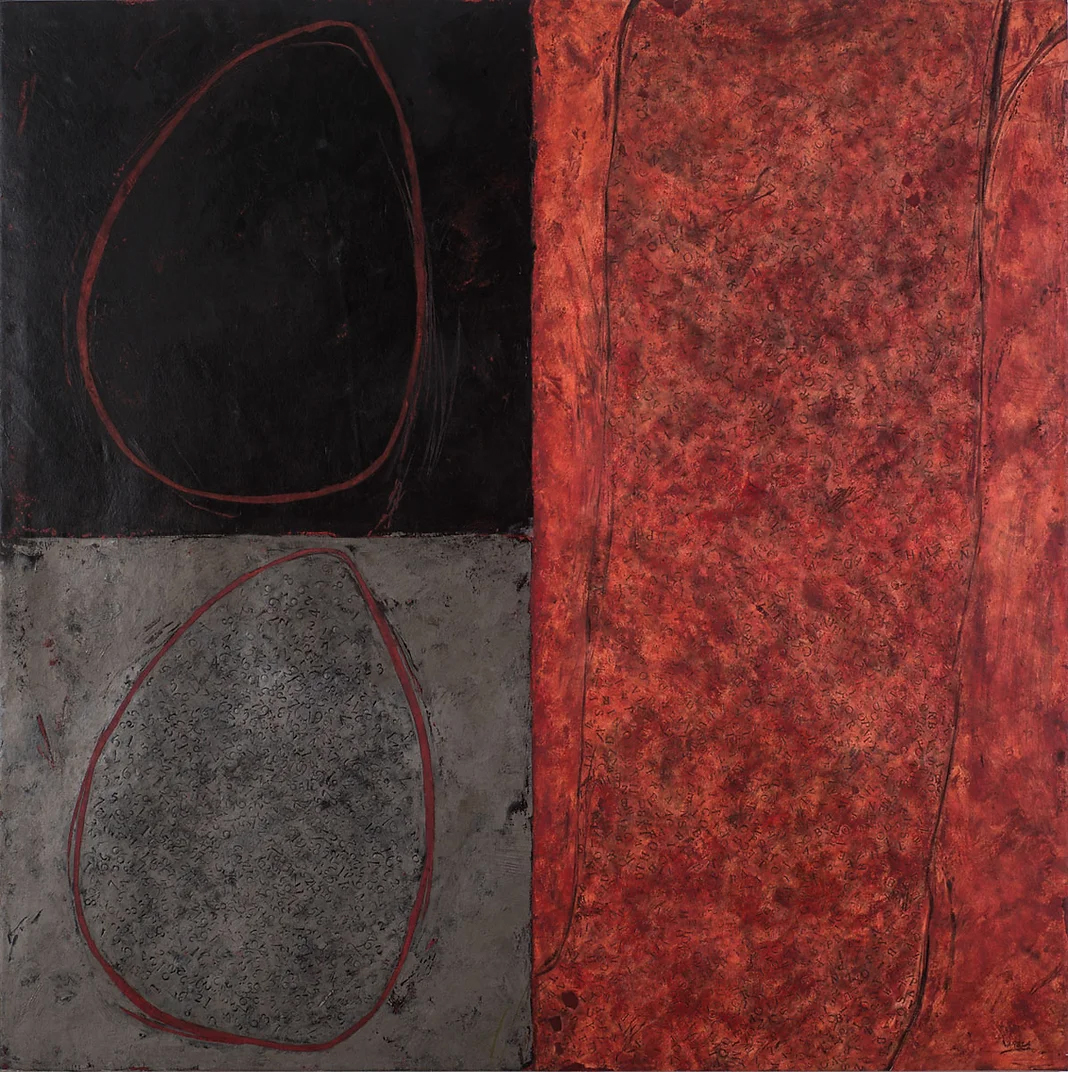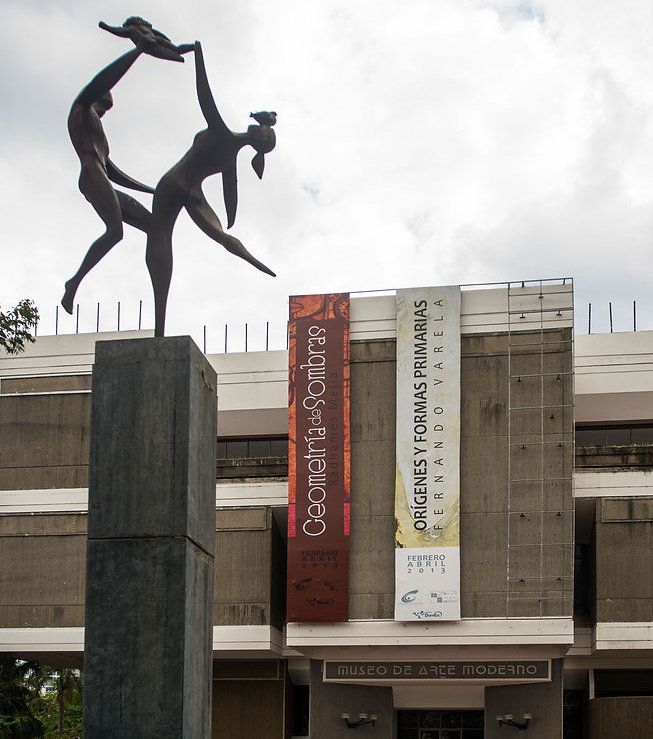When considering this text, I found myself in a dilemma to decide how to approach it, a conflict that ended when I understood that the most honest way to do so was to share the experience lived when interacting with the piece. Experiencing what some theorists call “the experience of art”, “experiencing the work”; and certainly, such an encounter with the piece did not occur in any other way. In relation to the work of Fernando Varela, it was not the first time that it happened to us, such an experience had already been experienced, in the same Museum of Modern Art in 2005, when Varela exhibited “The quiet word”, a set of canvases in which upon entering into intimacy with them, we discover an alphabet spread on all surfaces overflowing with an astonishing and forceful silence, the silence of plenitude. We had no choice, in that first moment, but to see, feel and remain silent.
Those of us who are related to Varela's work know of his journey in search of his inner being, a spiritual search that began in his early youth. We have seen material evidence of that search in his series of paintings: Origins, and Primary Forms; and the already mentioned, The silent word. In Origins and Primary Forms we find the multiple, the symbolic, the asymmetrical, the rational, all of this expresses his deep convictions about life and those transcendent aspects that justify human existence expressed in an essential way, with austerity but in perfect harmony. If years ago, The Quiet Word induced us to silence, the set presented to us in Origins and Primary Forms induces us to scrutiny, what Robert Rosenblum (1927-2006) called “The abstract sublime” to refer to those feelings and emotions. that the works of Still, Rothko and Pollock transmitted to him.
On this occasion, and in a personal capacity, Varela invites us to share something that has been revealed to him through innocence: a form that after detaching itself from a material surface leaves a void equal to it. The above formulated is presented to us in a model, or study for a collage, which would later become the installation titled Forma y Vacío and which would be part of his proposal in Orígenes y Formas primaris exhibited at the Museum of Modern Art of Santo Domingo. In the conversation, questions arise that may not be answered: What was the meaning of that revelation? How is Forma y Vacío linked to your other pieces, this one that from its materiality seems different from the set exhibited in Orígenes y Formas primaris? In the first instance, that was the challenge of deciphering, an intellectual exercise that became an experience. In a first, simple approach, the piece in question is an installation, but it is also a large collage, of formal and chromatic austerity, composed of ovoid shapes cut out of a white material that rest on a rectangular surface of the same material, but in black . Upon recognition, relationships arise, images arrive in forms previously seen in his canvases that ratify the correspondence, constancy and coherence of the artist: expressing with images the reflections and results of his inner search. This result, which is presented in paintings, drawings, objects and now collages, is impregnated with all that discourse and formal elements that are evident in his other works: duality, the antagonistic, the first forms, the monochromatic, and the paradoxical as a powerful element of reflection.
The work invites contemplation, that state of consciousness at rest, to be in its presence and let it rest as it is in its essence. At first that is perhaps being form and emptiness at the same time. But, as we had already mentioned, the antagonistic is present in Varela's works and in Forma y Vacío the opposites cohabit, both conceptually, formally and perceptually. While it is true that elevated truths and subtle revelations can emerge in contemplation through a deep connection with the work, in contrast to this, what is not easily revealed to us moves us to want to delve into its components, examine them and decipher them. , confronting the artist's intention with the elements (symbols) of his work in an introspective process towards the center of the piece and its property, and from there returning to silence, to the contemplative.
Philosophical and sometimes mystical reflection, according to the artist's words, determine the formal and conceptual characteristics of his works. His search is internal and manifests itself both in his physical being and in his artistic being, a search that does not ignore the aspects, whether in the order of the material or the spiritual, of the origin of life that in a The first state conceives the first, original, ovoid form as the germ of that mystery; recognizable in the “Origins” and “Symbols”, elements of that grammar with which Varela articulates his pieces.
In Form and Void, the space in which the composition operates takes us to a large-format, rectangular surface, although not perfect, just like the shapes and voids that rest on it. If we refer to the rectangular shape, we will find in it that space where the human being feels comfortable and safe; It is one of the most frequent forms in the design and construction of its objects of use and living spaces: Houses, rooms, beds, tables, are erected based on the rectangular.
In that rectangle, the ovoid shapes that emerge, leaving a void equal to them, suggest multiple denotations associated with the initial, and with the created or existing. The egg, an image that is repeated in different cultures throughout time, is a symbol of the potential, of the germinal. According to alchemy, it contains matter and thought, a visible and invisible form of life. At the same time, it is a cosmic symbol that also refers to the earthly sphere. The ovoids, in Form and Void, displayed in three units refer us to spiritual synthesis. The presence of three resolves the conflict posed by the dual, a reaction of the action on two, and sufficiently expresses the development of the unity within it. The fact that the rectangle is placed as a vertical axis indicates a higher stage of life.
In the whole, black and white interact in their two implications: one, as tension between “colors” and the other, as elements that are contrary symbols. The contrast between the two allows the shapes (white) to stand out as they differ from the background (black), the line that is created by cutting them out is revealed by the contrast with the black that remains impassive, serene, mute. In it the forms interact in a subtle way producing a vibration that prints a slight, barely perceptible movement, which is transformed into energy, converting our rectangular space into the space of the possible. A transformation can occur there. It is perhaps the representation of the movement of the spiritual that Varela told us about when he pointed out, referring to the emergence of primary forms, that the action of energy on a point has an impact on the form, modifying it, giving way to other possible forms; This action can be repeated from eternity to eternity.
Having scrutinized the forms, we are still left with emptiness. “A form that after detaching itself from a material surface leaves a void equal to it”, that is actually the big question in this piece. A question that Zen Buddhism had already raised and that we find expressed in the Heart Sutra: “Form is emptiness, emptiness is form; form does not differ from emptiness, emptiness does not differ from form; Whatever is form is emptiness, whatever is emptiness is form.” In spiritual terms, without delving into the depths of the Sutra, in both Varela's piece and the Heart Sutra there is no conflict between one and the other (form and void). In both cases unity prevails because they contain and are one.
Form and emptiness are the absolute. It is a state of full consciousness that is not intellectualized, but is lived, intuited, a state in which the human being can live and at the same time receive the external manifestations (forms) as they present themselves. We should not confuse this emptiness with nothingness, with absence, because in this case, being a container and content, it is plethoric and could be considered a high stage of spiritual life where the dual, the contradictory, the ego, ties, prejudices, the intellect, they disappear. These revelations, combined with the arrangement of the rectangle on a vertical axis, confirm the representation, in the piece, of a higher stage of life and consciousness. Always helping ourselves with the paradox in this reflection, we understand that Form and Void constitute a space of gestation and a space of plenitude. Its communication actions take us from the sublime to the contemplative, understanding the sublime as that which moves us and the contemplative as that state of absolute rest. In Form and Void, the spiritual achieves material consistency.
It is possible that in a space so saturated with images and objects, attached to the material and the tangible, such as the space of the 21st century, it could seem contradictory for a visual artist to want to express through the visible a state of consciousness and a spiritual world not visible but existing. In this case we must not forget that first spirit of abstract art that Fernando Varela embraces, both in its conceptual and formal basis, that although he saw art as an instrument of spiritual expression, he also managed to draw attention to himself through it. itself, about its materiality, as well as its meaning. As Arthur Danto points out: abstract art pointed to totally new spaces, an observation that is still accurate today because those spiritual spaces of the human being remain virgin, new, in the face of the overwhelming wave of communication spaces loaded with messages. The work of art generates a type of communication opposite to the one we know today and that more than communicates it induces, and in this case takes us to our initial position: contemplation.
Bibliography
–Watts, Harriet. Arp, Kandinky, and the Legacy of Jackob Boheme. In: The spiritual in art abstract painting 1890-1985. USA, Los Angeles County Museum of Art, 1986.
– Kuspit, Donald. Concerning the spiritual in the Contemporary Art. In: The spiritual in art abstract painting 1890-1985. USA, Los Angeles County Museum of Art, 1986.
– Planell, Joaquiín, Analysis in plastic art. Fundamentals. In: The interpretation of the work of art. Madrid, Editorial Complutense, 1996.
– Kansdinsky, Wasielf. Of the spiritual in Art. Lual Publishing House, 1992.
– Tola, Fernando, Dragoneti, Carmen. Mahayana Buddhism. Argentina, Kier, 1980.
– Cirlott, Eduardo. Symbols dictionary. Barcelona, Labor, 1994. -Varela, Fernando. Form and Void. Video, 2013.
– Notes from my visit to Fernando Varela's studio, January 29, 2013.

